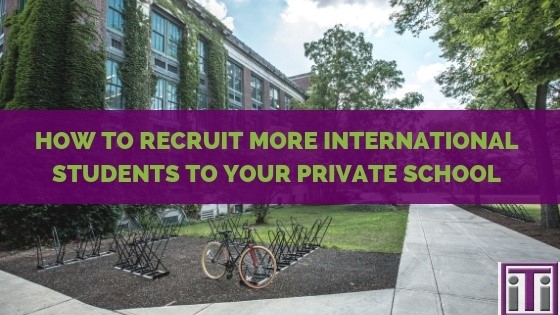
International students are increasingly flocking overseas. They come to North American schools and universities to perfect their language skills and earn prestigious degrees. Many schools, colleges, and other higher education institutions are capitalizing on this niche market. Those schools are reaping the rewards of increasing their enrollment figures. Consider these thoughts on how your school can successfully do the same.
Speak Their Language
Private middle schools, independent high schools, and universities can attract more non-U.S. students by appealing to those students and their families in their native language. Some smart school admissions departments and marketing departments are becoming more ethnically and culturally diverse. They’re drawing students from across national borders by demonstrating their school has the services and staff needed to make a transition to the United States easier. But the effort must be more than a token. Your school cannot just advertise you’re open for international students and hire one admissions person who speaks several languages. That’s not the way to succeed as it is not realistic for one or a small group of people to do all the interpreting and translation duties.
What are the benefits of hiring a professional interpreter or translator?
Start By Defining Your Student Personas
On its website, Higher Education Marketing recommends each school or university define unique parent/student personas. These are detailed descriptions of the type of students and families who do well at your school. Typical personas include a number of descriptors and characteristics like: average age, place of residence, average number of children, what they look for most in a private school, concerns/pain points, who is most likely to influence their decisions, how they research and discover schools to consider, fields they want to study, and others.
Once your school knows your specific target audiences and what they’re looking for in a school, be sure your admissions and marketing materials are geared to those wants and needs. You’ll cut through the noise and connect with international students and parents in a meaningful and persuasive way.
Think Like An International Student And Parent
Put yourself in the shoes of students and families who are considering a school in the United States. Think about their concerns. For example, students want to study where they are accepted, where other cultures are embraced, and where they won’t feel alone. Parents want the peace of mind of knowing they can easily communicate with your school staff—not just to one person but to several. What else would be on your mind if you were going to study in a foreign land? What would be your top concerns if your child was going abroad where communication with many people will be challenging?
Most international students have very different needs and expectations than their domestic counterparts. Depending on the countries you recruit from, the students have different cultures and varying degrees of independence. The better you narrow down the type of students you want to attract and the better you understand their culture, background, and needs, the better you will become at attracting and retaining those students.
Translate Your Online Presence
A large majority of international students begin their research to study abroad through internet searches. Once you’ve identified the international markets your school wants to attract students from, be sure your online presence is easy for students in that country to find and use.
For example, you want to be prominent on the search engines used most frequently by your targeted groups. If you want to attract students from South Korea you want to be on the search engine Naver because it’s the most widely used in that country and has a 70% share of that market. To attract Chinese students you want to be on Baidu, China’s most popular search engine.
Next, create website content specifically for international students. Provide that content in the students’ native language. That shows your school considers those students a priority. Don’t just feed existing English content into an electronic translator. That will most likely produce grammatical and contextual errors (more on the dangers of Google Translate). Invest in professional translation services to ensure your school’s website content makes sense to native speakers of the language. And localize your content. Spanish is spoken and written differently in Spain than it is in South America, for example. Even if you’re targeting a region that speaks English, creating localized versions of your existing content is advantageous. The English language in the United States does not always match up with the English language as used in England and elsewhere.
Be aware of not just the language differences but also of the cultural differences. Students from some parts of the world react negatively to certain colors. Pictures and images that might be appropriate for a U.S. audience may offend certain foreign students. Find a local expert on the language and culture of the students you want to attract and have that expert review your content and graphics.
Offer Language Services In Multiple Areas
In at least three areas you’ll want to make communications available in your target student’s native language. Of course, your school’s marketing materials, applications, brochures, social media, and handbooks must be in the student’s native language.
You’ll also want to have translation services for the student’s medical records, educational records, transcripts, and more. Make a list of everything you use to enroll students and place them in the right programs and make sure everything on the list has a translated version.
Learn from Others and Consider Partnering
Many schools and universities in the U.S. don’t have the knowledge and resources to recruit international students globally. Just translating your school website and participating in a few recruitment fairs in other countries won’t produce meaningful results. If your school doesn’t have access to major recruitment infrastructure and resources, learn from others. Do your research and see what other schools have done to attract international students. And considering partnering with another school to share the costs.
Stand Out and Attract More International Students
Offering translation services is a great way to differentiate your school from your competitors. Use the ideas here, seek out recruitment events, and consider consulting with international student agents and consultants. The rewards can include increased enrollment, a more diverse and culturally rich student body, and a more solid foundation for future enrollment.
Want more information on how to attract more international students? Download our free guide on “how to create an all-inclusive scholastic experience for international students”.






Comments are closed here.